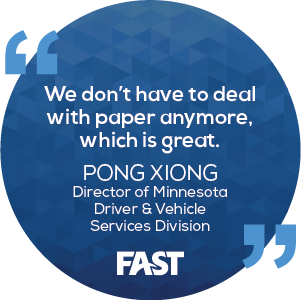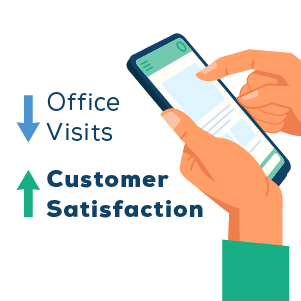E-Titling: Objects in the Mirror Are Closer Than They Appear
In the motor vehicle industry’s journey toward electronic titling, your agency may already be in the express lane. Find out how you can leverage existing technology to clear work backlog, save time and money, and increase customer convenience and trust.
By Frank Dean
Another car sold, another bundle of documents to compile and send off. For the next 90 days, as paper is shuffled from one party to the next, the dealer will call your agency every other week wondering where the title is. To top it off, the car purchaser will call too! When it’s finally sent, it gets lost in the mail and the process restarts.
On the whole, the process hasn’t changed that much over the past few decades.
So why haven’t more states digitized title processing yet?
In some cases, antiquated laws that have not caught up with modern technology are the problem. Other times, it’s a lack of resources. Every year, I speak with motor vehicle agency employees who are interested in e-titling but aren’t sure how to achieve it in their state. In many of these conversations, I realize several agencies already have the most of the technical capabilities needed to implement e-titling and e-registration—they just don’t realize it.
That’s right: in the motor vehicle industry’s journey toward electronic titling, your agency may already be in the express lane. Here’s what you can achieve by leveraging your existing technology:
Clear the Backlog
E-titling and e-registration means fewer office visits for title printing or because the customer brought the wrong paperwork. Digitizing this process and integrating it into your overall software system also gives your staff easier access to data and streamlined task management. With shorter lines and a smarter workflow, staff are free to devote more time to higher-value activities.
Promote Trust
Titling and registration are a key part of consumer protection and road safety, but dealers also need a secure and efficient way to track and manage vehicle ownership. By modernizing these services, you can minimize the risks associated with paper titles, such as fraud, loss, or damage, and increase constituents’ confidence in your agency.
Save Time and Money
Printing, organizing, and mailing paper documents uses valuable time and resources. The Minnesota Driver and Vehicle Services (DVS) division saw major improvements in this area after implementing e-liens for all stakeholders in April 2022. “Every single vehicle that comes in through e-lien now saves us a postcard, saves us postage,” DVS director Pong Xiong said in Episode 110 of AAMVAcast. “We don’t have to deal with paper anymore, which is great.”
Put Convenience First
In states that have already begun this process, convenience is king. The Maryland Motor Vehicle Administration used technology to get titling down to same-day processing, which makes life easier for all involved: car owners, dealers, lienholders, banks, and agency staff. In New Mexico, consumers can transfer a vehicle title online, which reduces DMV office visits. And Xiong called Minnesota’s e-liens a “big benefit to customers,” as it’s “one less piece of paper they need to bring in.”
If you’re ready to make these changes in your agency, you may be closer than you realize. It’s simply a question of modern policies aligning with modern technology. Get started today by contacting Frank Dean at fdean@fastcore.com.


 In some cases, antiquated laws that have not caught up with modern technology are the problem. Other times, it’s a lack of resources. Every year, I speak with motor vehicle agency employees who are interested in e-titling but aren’t sure how to achieve it in their state. In many of these conversations, I realize several agencies already have the most of the technical capabilities needed to implement e-titling and e-registration—they just don’t realize it.
In some cases, antiquated laws that have not caught up with modern technology are the problem. Other times, it’s a lack of resources. Every year, I speak with motor vehicle agency employees who are interested in e-titling but aren’t sure how to achieve it in their state. In many of these conversations, I realize several agencies already have the most of the technical capabilities needed to implement e-titling and e-registration—they just don’t realize it.


